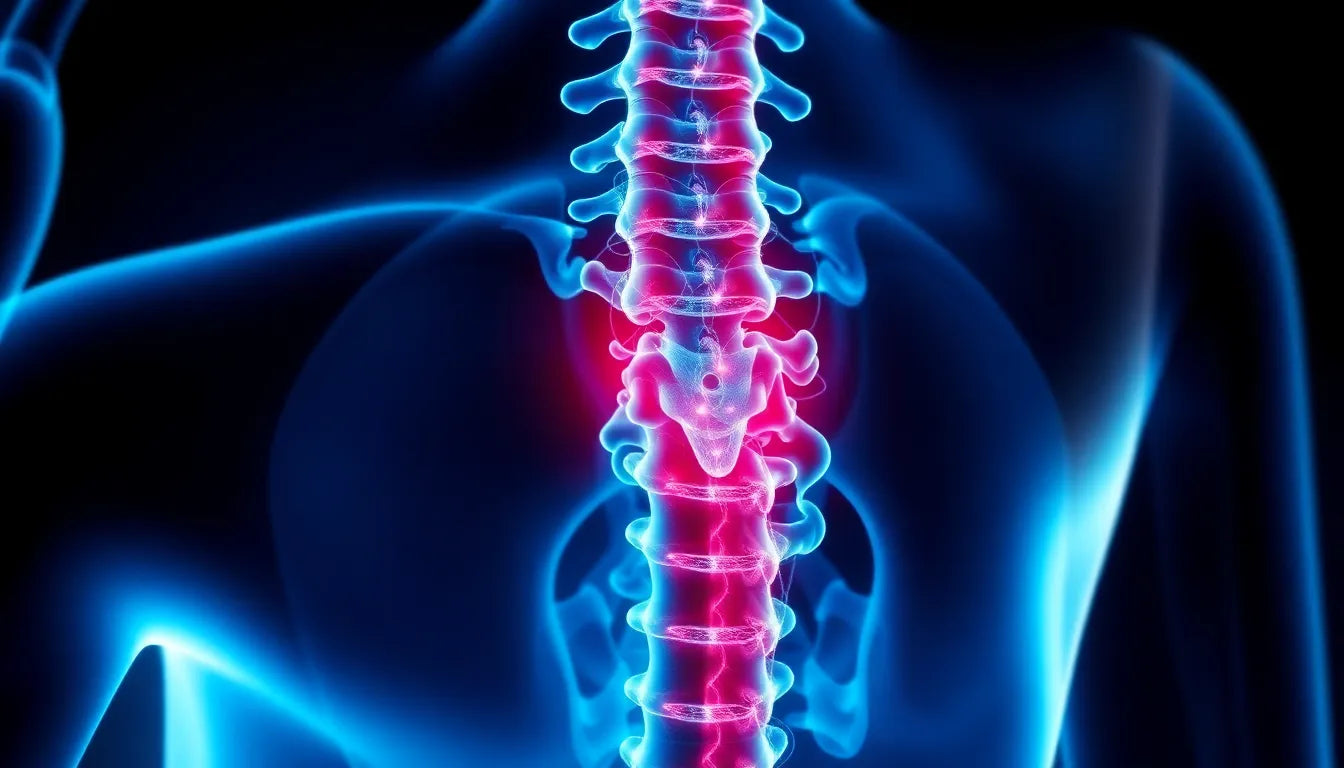Back pain is a prevalent issue that affects millions of individuals worldwide, often hindering daily activities and diminishing quality of life. Among the myriad causes of back pain, osteoarthritis and herniated discs stand out as common culprits. Understanding these conditions is crucial for effective pain management and enhancing one's overall well-being.
Osteoarthritis in the back, also known as spinal osteoarthritis, is primarily characterized by the degeneration of the facet joints and intervertebral discs. This condition is typically associated with aging, leading to chronic pain, stiffness, and reduced mobility. As the cartilage that cushions the joints wears down, the bones begin to rub against each other, causing discomfort and inflammation. The symptoms of spinal osteoarthritis can vary in severity, but they often result in persistent back pain that can significantly limit one's ability to perform everyday tasks.
Herniated disc: understanding the condition
In contrast, a herniated disc occurs when the material inside an intervertebral disc protrudes through the outer layer, often impacting nearby nerve roots. This displacement can lead to symptoms such as shooting pain, numbness, and tingling, which are particularly pronounced in the legs and arms due to nerve involvement. Unlike osteoarthritis, which is primarily a degenerative condition, herniated discs can result from sudden injury or strain, making them a distinct yet sometimes overlapping issue with osteoarthritis.
Diagnosing back pain can be complex due to the overlapping symptoms of osteoarthritis and herniated discs. Both conditions can cause significant discomfort and reduced mobility, but the nerve-related symptoms of herniated discs often provide a clue for differentiation. Understanding these nuances is essential for developing a targeted treatment plan that addresses the specific needs of each condition.
As we delve deeper into these conditions, it becomes apparent that a comprehensive approach to diagnosis and treatment is necessary. By recognizing the unique characteristics of osteoarthritis and herniated discs, individuals can take proactive steps towards managing their symptoms and improving their quality of life. The complexity of these conditions underscores the importance of seeking professional medical advice to ensure accurate diagnosis and effective management strategies.
Diagnosis and overlapping symptoms of osteoarthritis and herniated discs
The diagnostic process for osteoarthritis in the back and herniated discs typically begins with a thorough clinical history and physical examination. Physicians may ask about the onset, duration, and intensity of pain, as well as any accompanying symptoms such as numbness or tingling. Imaging techniques, such as X-rays, MRI, or CT scans, are often employed to provide a detailed view of the spine's structure. These tools help in identifying the extent of joint degeneration in osteoarthritis or the presence of a herniated disc.
Both osteoarthritis and herniated discs can lead to significant back pain and reduced mobility, making it challenging to distinguish between the two based solely on symptoms. However, herniated discs are more likely to cause pronounced nerve-related symptoms, such as shooting pain, numbness, and tingling, particularly in the limbs. These nerve-related symptoms often guide physicians in differentiating between the two conditions, enabling them to tailor treatment plans more effectively.
Treatment options for osteoarthritis in the back
Lifestyle modifications for managing osteoarthritis
Effective management of osteoarthritis in the back often begins with lifestyle modifications. Physical therapy plays a crucial role in maintaining mobility and strengthening the muscles that support the spine. Tailored exercise programs can help reduce stiffness and improve flexibility, while weight management is essential to alleviate stress on the joints. Incorporating low-impact activities such as swimming or cycling can also enhance overall fitness without exacerbating symptoms.
Medications for osteoarthritis pain relief
Medications are a cornerstone in managing osteoarthritis pain. Nonsteroidal anti-inflammatory drugs (NSAIDs) like ibuprofen and naproxen are commonly used to reduce inflammation and alleviate pain. Acetaminophen can also be effective for pain relief, particularly for those who cannot tolerate NSAIDs. In some cases, doctors may prescribe antidepressants such as duloxetine, which have been found to aid in chronic pain management by altering pain perception pathways.
Supportive and alternative therapies
Supportive therapies, including the use of hot and cold packs, can provide temporary relief from pain and stiffness. Manual therapy, such as massage or chiropractic adjustments, may also help in reducing discomfort and improving mobility. Assistive devices like braces or walking aids can offer additional support, particularly during flare-ups.
For those seeking alternative treatments, acupuncture and transcutaneous electrical nerve stimulation (TENS) have gained popularity as complementary therapies. Acupuncture involves the insertion of fine needles into specific points on the body to relieve pain, while TENS uses low-voltage electrical currents to disrupt pain signals, offering another avenue for symptom management.
Injection therapies for severe osteoarthritis pain
In cases where conservative treatments are insufficient, injection therapies may be considered. Corticosteroid injections into the facet joints or epidural space can provide significant relief by reducing inflammation and swelling around the nerves. Anesthetic injections may also be used to temporarily alleviate severe pain, allowing patients to engage more fully in rehabilitation activities.
Treatment approaches for herniated discs
The treatment of herniated discs often mirrors that of osteoarthritis, with an emphasis on non-surgical interventions. Physical therapy is vital in strengthening the back muscles and improving flexibility, which can help alleviate pressure on the affected nerve roots. Pain management strategies, including the use of NSAIDs and muscle relaxants, are commonly employed to control symptoms.
In more advanced cases, where conservative measures fail to provide adequate relief, surgical options may be explored. Procedures such as discectomy or laminectomy aim to remove or relieve pressure from the herniated disc material, offering significant symptom relief. However, surgery is typically reserved for cases with severe nerve involvement or when other treatments have been exhausted.
Integrating treatment strategies for osteoarthritis and herniated discs
Effectively managing osteoarthritis in the back and herniated discs requires a comprehensive approach that combines both conservative and interventional therapies. Tailoring treatment plans to the individual's specific needs is crucial, as it allows for a more targeted approach to addressing symptoms and improving quality of life. By integrating physical therapy, medications, supportive therapies, and, when necessary, surgical options, patients can achieve better outcomes and gain more control over their condition.
Empowering patients to take an active role in managing their conditions is also essential. This involves educating individuals about their condition, treatment options, and lifestyle modifications they can adopt to alleviate symptoms and prevent further deterioration. Encouraging self-management practices, such as regular exercise, weight management, and ergonomic adjustments, can significantly enhance the effectiveness of medical treatments and improve overall well-being.
Frequently asked questions
What is the main difference between osteoarthritis and a herniated disc?
Osteoarthritis involves the degeneration of the facet joints and intervertebral discs, leading to chronic pain and stiffness. In contrast, a herniated disc occurs when the disc material protrudes through the outer layer, often affecting nearby nerves and causing symptoms like shooting pain, numbness, and tingling.
Can both conditions occur simultaneously?
Yes, it is possible for individuals to experience both osteoarthritis and a herniated disc concurrently. This can complicate diagnosis and treatment, as the symptoms of both conditions can overlap, leading to challenges in identifying the primary source of pain.
What are the first steps if I suspect I have one of these conditions?
If you suspect you have osteoarthritis or a herniated disc, it is important to seek medical evaluation for an accurate diagnosis. This typically involves a clinical assessment and imaging techniques, such as X-rays or MRI scans, to determine the extent of joint degeneration or disc herniation.
Are there any preventive measures for osteoarthritis and herniated discs?
Maintaining a healthy weight, engaging in regular exercise, and practicing proper ergonomics can help reduce the risk of developing osteoarthritis and herniated discs. These preventive measures can also alleviate symptoms and slow the progression of existing conditions.
When should surgical options be considered?
Surgical options are generally considered when conservative treatments fail to provide sufficient relief, particularly in cases of severe herniated discs with significant nerve involvement. Surgery may also be necessary for advanced osteoarthritis if there is severe joint destruction that impairs daily functioning.
By understanding the differences between osteoarthritis and herniated discs, and by implementing a comprehensive treatment plan, individuals can effectively manage their symptoms and improve their quality of life. It is crucial to work closely with healthcare professionals to determine the most appropriate strategies for each unique case, ensuring that both conditions are addressed with the best possible care.


















